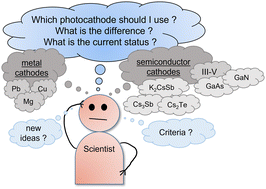Review of photocathodes for electron beam sources in particle accelerators
Abstract
This paper compares different photocathodes that are applicable for electron injector systems and summarizes the development in cathode technology in the last years. The photocathode is one of the key components of the facilities that provides electrons for many research experiments. Typically, a high efficiency and a long operation time are desired, thus the photocathode needs to be robust against any rest gases occasionally available during operation. Low thermal emittance and fast response time are special requirements for the accelerator community. These parameters are commonly used to compare the various cathode materials. Metals and plasmon-enhanced materials emit electrons from the near surface, whereas semiconductors emit photoelectrons mostly from the bulk region. We compare metal photocathodes such as magnesium, copper and lead, with semiconductor photocathodes such as cesium telluride, antimonide photocathodes and III–V semiconductor photocathodes. GaAs and its typical application for the generation of spin-polarized electrons is discussed and special attention has been paid to the emerging GaN as a potential novel photocathode. The above mentioned state-of-the-art cathodes are compared regarding their preparation approaches, quantum efficiency, lifetime, response time and their status of application. This work is aimed to provide a guideline for particle accelerator researchers in their choice of the cathode material. Thermionic cathodes and field emission cathodes are not discussed in this review.

- This article is part of the themed collections: Journal of Materials Chemistry C Recent Review Articles and #MyFirstJMCC


 Please wait while we load your content...
Please wait while we load your content...